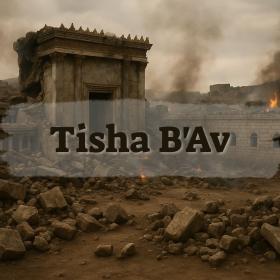The Ninth of Av: How Catastrophe Transformed Judaism

The Ninth of Av: How Catastrophe Transformed Judaism
Dr. Liron Biran Nisenholz
When I asked a colleague and a mentor of mine, what would be the best way to articulate to my students the value of the Temple in Jerusalem, to my great astonishment, she used none of the spiritual imagery I assumed she would. Instead, she, a true Bostonian at heart, referred me to Fenway Park. "It isn't just about baseball," she said, "Just like the Temple wasn't just about spirituality. It's the immersive feeling you get as soon as you come near Fenway Park and see all the others making the pilgrimage as well. Right off the bat, you get a strong sense that you are a member of this awesome community. Coming to Fenway Park for the first time is a rite of passage. Sitting on the bleachers, even if you couldn't care less about the game, still feels like you're part of something great that you experience with all of your senses."
When I shared that notion with my class and asked them about their version of the Temple, they mentioned various places that had one thing in common: they all gave them a sense of home, a 'Bait' [בית]. The Hebrew language cleverly paired this word with 'Mikdash' [מקדש] to describe our people's temple. While Mikdash can describe any place of worship, Beit HaMikdash is the house of worship. Our house of worship.
As long as it stands, that is.
Imagine if tomorrow, every sacred space you knew was suddenly destroyed, and your entire religious system had to reinvent itself. This is precisely what happened to ancient Judaism on the ninth day of the Hebrew month of Av—a date that became synonymous with catastrophe. On this day in 586 BCE, the Babylonians destroyed the First Temple in Jerusalem. Centuries later, in 70 CE, the Romans destroyed the Second Temple on the exact same date.
The Temple wasn't simply a place of worship; it was the axis mundi—the spiritual junction between heaven and earth. Every aspect of Jewish religious life centered on Temple rituals: sacrifices for atonement, festivals, priestly ceremonies. When it vanished, Judaism faced an existential crisis that would have destroyed most ancient religions. But instead of disappearing, Judaism completely reinvented itself in ways that would fundamentally shape Western religious thought.
When the Temple fell, different Jewish communities responded in dramatically different ways. Some abandoned Judaism entirely, assimilating into Hellenistic culture or converting to Christianity, seeing the destruction as proof that God had abandoned the covenant. Others became extremist "Mourners of Zion," refusing to eat meat, drink wine, or marry—essentially giving up on normal life until the Temple could be restored. The priestly class, the Sadducees, led violent rebellions against Roman rule, convinced that there could be no Judaism without the Temple.
But the Pharisees and their intellectual descendants, the Sages, chose a radically different path. Rather than seeing destruction as God's rejection of Israel, they interpreted it as a divine call to serve in an entirely new way. This theological reframing would prove to be one of the most consequential religious innovations in human history.
The transformation that followed was nothing short of revolutionary. The Sages developed three fundamental innovations that not only saved Judaism but created a template for religious adaptation. First, they shifted religious authority from hereditary priests to anyone capable of learning and interpretation. Study became the new path to holiness, democratizing religious leadership centuries before other traditions would follow suit.
Second, they transformed the geography of the sacred. Instead of requiring one central location, Judaism became portable. Prayer replaced sacrifice, and every community could establish its own sacred space. The synagogue became a revolutionary institution that could be replicated anywhere Jews lived, making Judaism perhaps the world's first truly global religion.
Third, they shifted from priestly mediation to individual responsibility. Rather than relying on priests to intercede with God, each person became responsible for their own spiritual relationship through prayer, study, and ethical behavior.
Perhaps the most psychologically sophisticated aspect of this transformation was the development of "stylized mourning." The Sages faced a delicate balance: how to acknowledge the magnitude of the loss without allowing grief to become destructive. As one Talmudic sage argued: "To not mourn at all is impossible, as the decree was already issued. But to mourn excessively is impossible, as the Sages do not issue a decree upon the public unless a majority of the public is able to abide by it."
The solution was ingenious: they embedded small acts of remembrance into daily life while ensuring these didn't prevent normal functioning. Families would leave a small section of wall unfinished when building new homes, omit one dish from wedding preparations, or place ashes on a groom's forehead during his celebration. The message was profound: remember the loss authentically, but don't let it destroy your capacity to build, celebrate, and live fully.
This ancient transformation offers profound lessons that extend far beyond Jewish studies. The Jewish response demonstrates how communities can survive devastating setbacks not through restoration of what was lost, but through complete reimagining of possibilities. This has obvious relevance for contemporary communities facing existential disruption, whether through technological change, political upheaval, or cultural transformation.
The Ninth of Av also provides a sophisticated model for processing trauma. Rather than choosing between denial and paralysis, the tradition created a "third way" that honors loss while choosing life. Perhaps most significantly, this story illustrates how history's most important innovations often emerge precisely from limitation and crisis.
Whether you're Jewish or not, the Ninth of Av confronts us with universal questions: What are your personal "temples"—the core structures, relationships, or beliefs that give your life meaning and stability? How do you rebuild when those structures collapse? How do you honor loss while still choosing engagement with the future?
The tradition's answer is neither simple optimism nor cynical despair, but something more nuanced: the recognition that meaning can be reconstructed from the fragments of what was lost, and that the capacity for renewal is perhaps the most fundamentally human characteristic.
The Babylonian Talmud concludes with a remarkable promise: "Anyone who mourns for Jerusalem will merit to see its joy." This isn't merely about restoring a physical city—it's about the human capacity to transform devastation into renewal and create new forms of meaning from the ashes of the old.
In studying the Ninth of Av, we encounter one of humanity's most profound case studies in how catastrophe can catalyze transformation. These lessons remain essential in our own era of rapid change, offering wisdom and hope for navigating the inevitable destructions and reconstructions that define human experience.
Last Updated Date : 30/07/2025



